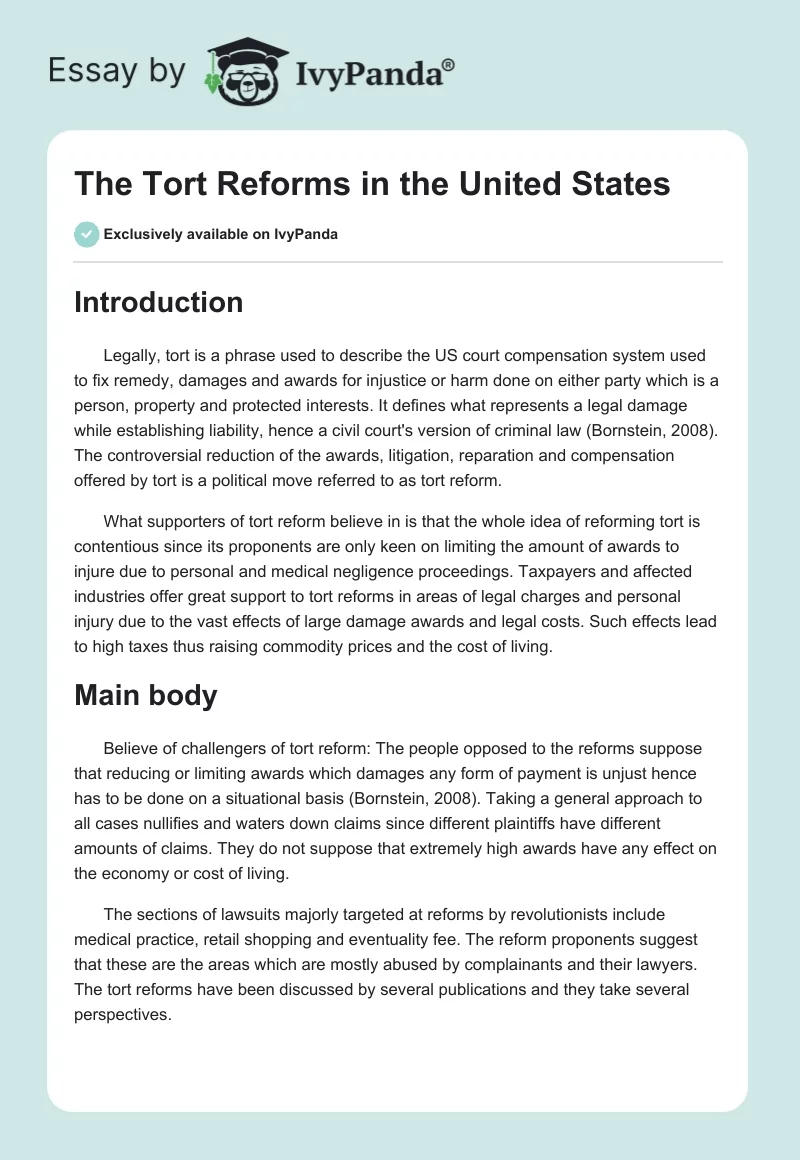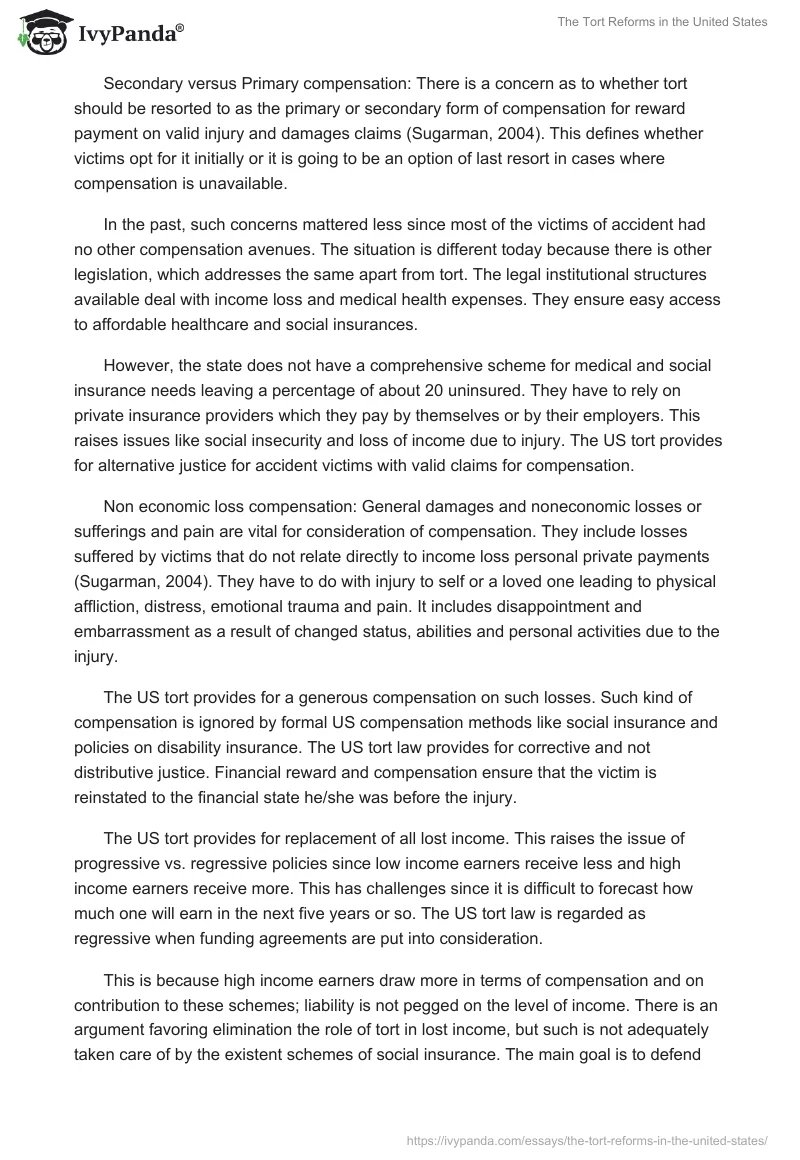Introduction
Legally, tort is a phrase used to describe the US court compensation system used to fix remedy, damages and awards for injustice or harm done on either party which is a person, property and protected interests. It defines what represents a legal damage while establishing liability, hence a civil court’s version of criminal law (Bornstein, 2008). The controversial reduction of the awards, litigation, reparation and compensation offered by tort is a political move referred to as tort reform.
What supporters of tort reform believe in is that the whole idea of reforming tort is contentious since its proponents are only keen on limiting the amount of awards to injure due to personal and medical negligence proceedings. Taxpayers and affected industries offer great support to tort reforms in areas of legal charges and personal injury due to the vast effects of large damage awards and legal costs. Such effects lead to high taxes thus raising commodity prices and the cost of living.
Main body
Believe of challengers of tort reform: The people opposed to the reforms suppose that reducing or limiting awards which damages any form of payment is unjust hence has to be done on a situational basis (Bornstein, 2008). Taking a general approach to all cases nullifies and waters down claims since different plaintiffs have different amounts of claims. They do not suppose that extremely high awards have any effect on the economy or cost of living.
The sections of lawsuits majorly targeted at reforms by revolutionists include medical practice, retail shopping and eventuality fee. The reform proponents suggest that these are the areas which are mostly abused by complainants and their lawyers. The tort reforms have been discussed by several publications and they take several perspectives.
Secondary versus Primary compensation: There is a concern as to whether tort should be resorted to as the primary or secondary form of compensation for reward payment on valid injury and damages claims (Sugarman, 2004). This defines whether victims opt for it initially or it is going to be an option of last resort in cases where compensation is unavailable.
In the past, such concerns mattered less since most of the victims of accident had no other compensation avenues. The situation is different today because there is other legislation, which addresses the same apart from tort. The legal institutional structures available deal with income loss and medical health expenses. They ensure easy access to affordable healthcare and social insurances.
However, the state does not have a comprehensive scheme for medical and social insurance needs leaving a percentage of about 20 uninsured. They have to rely on private insurance providers which they pay by themselves or by their employers. This raises issues like social insecurity and loss of income due to injury. The US tort provides for alternative justice for accident victims with valid claims for compensation.
Non economic loss compensation: General damages and noneconomic losses or sufferings and pain are vital for consideration of compensation. They include losses suffered by victims that do not relate directly to income loss personal private payments (Sugarman, 2004). They have to do with injury to self or a loved one leading to physical affliction, distress, emotional trauma and pain. It includes disappointment and embarrassment as a result of changed status, abilities and personal activities due to the injury.
The US tort provides for a generous compensation on such losses. Such kind of compensation is ignored by formal US compensation methods like social insurance and policies on disability insurance. The US tort law provides for corrective and not distributive justice. Financial reward and compensation ensure that the victim is reinstated to the financial state he/she was before the injury.
The US tort provides for replacement of all lost income. This raises the issue of progressive vs. regressive policies since low income earners receive less and high income earners receive more. This has challenges since it is difficult to forecast how much one will earn in the next five years or so. The US tort law is regarded as regressive when funding agreements are put into consideration.
This is because high income earners draw more in terms of compensation and on contribution to these schemes; liability is not pegged on the level of income. There is an argument favoring elimination the role of tort in lost income, but such is not adequately taken care of by the existent schemes of social insurance. The main goal is to defend the middle earners from income loss and deter high income earners from exploiting tort as a substitute for their income.
Sharing liability: Conventionally, the rule of law states that one whose personal carelessness leads to injury cannot make a claim as the one whose liability caused the injury. This avoids the tendency of wrongdoers thronging courtrooms with claims on the harm that could have been avoided (Chapman, 2010).
This has changed drastically with comparative fault analysis. Fault analysis implementation varies across states with them having a percentage fault for the victim and defendant. Some states bar claimants whose liability lay at 50% or more from making any claim for damages.
However, this lets off some wrongdoing defendants and denies the victims their justice. The US tort reform should take care of victim interests by ignoring victim fault under any circumstances. Victims always pay for their mistakes through financial loss due to physical injuries and damage. Therefore, defendants should pay for full liability or for the percentage of their fault.
Legal fees payment: Traditionally, the losing party settles all the legal fees involved in a lawsuit. However, every side takes care of their legal fees in the US. This is not true in real practice since the defendants win or lose have their fees settled by their liability insurance (Sugarman, 2004). This means that the liability insurer also participates in selecting the defense lawyer. Plaintiffs also have an insurance provision.
A shortcoming of the US system is that victims have to pay their legal fees from the compensation. Such payments are normally high since they present a percentage of the award hence the victim is under-compensated. In an accident that leads to injury to the litigant, legal fee ought to be handled as any other recoverable cost. The US tort recovery increases with the extent of the injury but, the claimants’ lawyer does not do much to earn this.
Punitive awards: Punitive damages are awarded in tort cases for justifiable offensive conduct. Punitive awards are two way since they serve the purpose of deterring other offenders as well as perform as a normative act that depicts shock and fury at the defendant’s act (Nolan and Ursin, 1995).
Punitive awards have been a matter of concern to the defense and their lawyers, leading to limiting and reducing in the number of such awards by trial judges. They also complain that some minor risk of likely punitive awards leads to them offering overly generous compensation. Others complain that punitive awards have been granted for misconducts do not merit. Some states have limited such awards to the level of responsibility and liability or eliminated punitive awards altogether.
Punitive awards on medical and non-economic damages are a major target of limits by individuals and organizations like businesses, health facility providers and physicians who are prone to being sued. In some cases, such compensation or a portion of it goes to set special funds or treasury. The US Supreme Court regards some of the awards as a violation of the constitution. The US tort provides an alternative for settlement in such controversial circumstances.
Conclusion
From sources anlyzed above, it is evident that there has been the implementation of a significant number of tort reforms by various States in America. Such reforms are sometimes controversial with their proponents and opponents challenging each other. Non-economic awards and injury are historically the most challenged provisions of tort. There has been a mixture of results by different states for litigants expressing concerns about the laws.
The changes to tort reflect more on primary values that justify the benefits payment to the injured. This is for cases where there is no other compensation plan provided for by conventional law mechanisms. This guarantees that a reasonable share of tort compensation satisfies a genuine need of the affected victim. Implementation of these reforms gives tort an upper hand in addressing social and medical issues.
Evaluation of tort reforms is complex because various states have adopted different approaches to implementing the reforms. The basic approach towards the reforms is uniform with a few differences in limit caps and compensation procedures (Mary, 2012). Some have pursued the reforms irrespective of whether they favor the defendant or plaintiff to enhance fairness in the tort justice system.
References
Bornstein, B. H. (2008). Civil juries and civil justice: Psychological and legal perspectives. New York: Springer.
Chapman, R. (2010). Culture wars: An encyclopedia of issues, viewpoints, and voices. Armonk, N.Y: M.E. Sharpe.
Mary H. G., (2012). Reclaiming Justice: Battling Tort ‘Reform’. American association of Justice. 48(12). Web.
Nolan, V. E., & Ursin, E. (1995). Understanding enterprise liability: Rethinking tort reform for the twenty-first century. Philadelphia: Temple Univ. Press.
Sugarman, S. (2004). Tort Reform Through Damages Law Reform: An American Perspective. Web.


